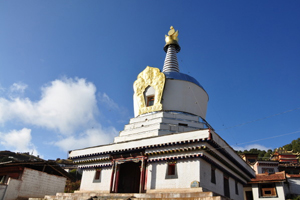|
Mogao Grottoes
| Mogao Grottoes, again known as “Thousand Buddha Caves”, are located at the cliffs of the Soughing Sand Hill some 25 kilometers to the southeast of the city of Dunhuang. The name of the grottoes is a derivation of the township named Mogao. Being the largest, the most well-known grottoes of Buddhism art in China they were caved out on the third and fourth floor, extending a length of 1.6 kilometers along the cliff. The grotto was initially dug in 366, the 2nd year under the reign Jianyuan of the Former Qin and now in existence are 492 caves with a total of 45,000 square meters of murals and 2,400 colored sculptures housed in them. The sizes of the caves are varied with the big ones looking robust and virile while the small icons are exquisite and delicate. The artistic attainment is so profound and imagination so rich that set people tongue-tied when viewing them. The fresco-contents are quite rich with most of them in connection with the Buddhism, for instance, the life story of Sakyamuni and his good deeds to others by sacrificing what was of his own. In addition, there are still a great number of Buddha-figures, Bodhisattvas, heavenly devas, tutelary deities, flying Apsaras and flowers and birds as well as other animals. Though they’ve been exposed to weathering in winds and sandstorms for over thousand years the colors of the murals are still bright with clear curve lines, that can not help but set people acclaim for the accomplishments in art and the creative sprits of the artists in China’s ancient times. The Mogao Grottoes are the largest “World Treasure-house of Art” so far in existence in the world and so the UNESCO listed it as one of the world cultural legacies in December in 1987. |


|
Maiji Hill Grotto
 | Located some 45 kilometers from Tianshui the Maiji Hill Grotto is one of the four famous grottoes in China. Covering an area of 215 square kilometers it includes several such scenic attractions as the Maiji Hill, Immortal Cliff, Stone Gate, Twisting Streams and the Old Town of Jieting.
Looking like a “wheat stack”, the name is derived from a folk saying “Chop away firewood on the Southern Hill to get the Wheat Stack Cliff built up”. The Maiji Hill enjoys a typical Danxia (a wind-eroded formation) morphology. Rising abruptly from ground the hill stands 150 meter high in a secluded area of all greens. As early as the end of the Western Han Dynasty here used to be the summer resort of a well-known general Wei Xiao by name.
The Maiji Hill Grotto is the most grotesque one of all grottoes in China. Disposed perpendicularly on the cliff, the most renowned of them are the Seven-Buddha Pavilion and Ten-Thousand-Buddha Cave and some others. They are connected with plank-board passages and stairs, a breathtaking project that set the hearts of the people in their mouths when mounting. Elegant and graceful the grotto-art at the Maiji Hill features mainly of clay sculptures, the artworks being in a transitional period from the early Northern Wei to those of the Tang Dynasty, a medley of all styles of the time. In existence here are 194 caves overhanging on the southern side of the cliff with more than 7,200 stone carvings and clay sculptures and over 1,300 square meters of murals housed in them. The contents tell a thorough reflection of secular world with a rich expression of everyday life. Therefore, they are of very high artistic value and renowned as the “Museum of the Oriental Sculpture”.
Labrang Lamasery
 |
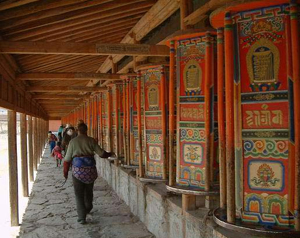 |
Located in the alluvial of the Daxia River at about a kilometer to the west of the Xiahe county seat the lamasery backs on the Phoenix Mountain and faces the Dragon Mountain. It is a place known as the “Gold Basin for Raising Fish“. The temple was initially built under the supervision of Jiamuyang, the first generation of Living Buddha in 1709, the 48th year in the reign of Kangxi of the Qing Dynasty. With the following living Buddhas to carry on the job it has now become the largest center for the Tibetan religious culture in Gansu, Qinghai and Sichuan provinces.
Covering an area of around 82 hectares with a floor space of 82,300 square meters the Labrang Lamasery consists of 6 scripture-chanting halls, 84 Buddha halls, 31 Tibetan style buildings, 30 palace-yards for Buddhas and over 500 meditation rooms as well as more than 10,000 abodes for lamas. Together with Drepung, Sera, Ghandam, Tashilhunpo and Ta’er monasteries in Tibet and Qinghai, they are considered the six sovereign monasteries for the Yellow Sect (Gelugpa) of the Chinese Tibetan Buddhism. Labrang is a transliteration of a Tibetan word pronounced as “Lazhang”, which means a place for the location of a Buddhism palace.
Pooled together wisdoms of the Tibetan, Han and Mongolian people, the monastery is renowned for its exquisite art of architecture and brilliance of religious culture. Kept in the monastery are all kinds of sutras, dividing into complete works, philosophy, Esoteric Sect of Buddhism, medicine, history, religion, biography, building technology, mathematics and poem and prose, etc, a total of 12 categories in 60,000 volumes. It is a monastery with the greatest collection of books. The monastery also runs six academies for religious and other teachings and learning, such as the Esotericism and medicine and so on. So it is the largest academy of Lamaism in China and the world as well. With a strict system of enrollment, teaching, examination and graduation it has nurtured a great many religious personnel for the Tibetan speaking regions.
Crescent Spring
The Crescent Spring at the Soughing Sand Hill, lying some 5 kilometers away to the southwest of the city of Dunhuang, is a mysterious landscape in the desert. Embraced all round by sand dunes a spring lake emerges with a pool of crystal water in their embrace. As it looks very like a new moon hence the name the Crescent Spring Lake. The Soughing Sand Hill, featuring a slope as though cut out, has soft, round and colorful sand-grains which go down soughing along with climbers and resumes as they used to be after a wind at night.
Stretching 240 meters in length and 39 meters in width with a depth of 2 meters the water side is grown with reeds and weeds, and in the water are seen some fish known as iron-plate, and seven-leaved water-weeds. The Crescent Spring becomes a marvel of nature for the “spring mirrors the moon with no dirt and silt nor will it be filled up by sand and dry up ever since ancient times” and with its shape looking like a new moon hence the name the Crescent Spring.
|
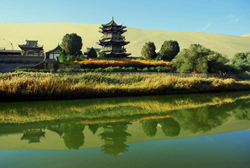 |
Kongtong Mountain
Towering some 15 kilometers to the west of the Pingliang City, the Kongtong Mountain, part of the Liupan Mountain Ranges has Guan Mountain by the north and Taitong to the south with Cock’s Head at its back and the Jing River in front. Known as a “picturesque scene for controlling the west” and “landscape at Kongtong, the prettiest under heaven” since ancient times the place has been one of the famous Taoist mountains of the country. The name of the mountain was derived from a Taoist expression, real emptiness and vacancy, a natural seclusion in quietness.
With an elevation of 2,123 meters the Kongtong Mountain covers an area of over 30 square kilometers. Having dozens of towering peaks they all look very magnificent as if wrought by superlative workmanship with a sea of forest roaring like billowing waves from the sky. Strange peaks, picturesque caves, weird rocks and scudding clouds contend one another with greenness, elegance and towering magnificence. The Kongtong Mountain, with the Jing River in front and Yanzhi River at the back, boasts a unique geographical environment, a magnificent of crouching tiger and curling dragon.
Langmu Lamasery
Located in Langmusi Township, the Langmu Lamasery is some 90 kilometers away to the south of the county seat of Luqu. Nestling by the side of the White Dragon River at the north foothill of Guo’ermangliang River, a branch of Xiqing Mountain, it is at the junction of Gansu, Qinghai and Sichuan Provinces.
As a lamasery for Tibetan Buddhism, Langmu means “fairy” in Tibetan language. In the cave there is a piece of rock standing elegantly and looking very much like a fairy and people has it hat the rock is an incarnation of the fairy, hence the derivation of the temple name. In addition, there is a tiger lair in the deep recess of the forest behind the temple and is known as “Dehecang” in Tibetan language. Therefore, the temple can also be called a “fairy in a tiger lair”.
Opposite the Ge’erdi Temple in Sichuan across the White Dragon River, the Lanngmu Lamasery has seen its heyday in its early days. Destroyed in 1969, the temple was reconstructed later year o year. In front of the temple there is a mountain looking very much like a monk’s cap and one sees a red cliff towering high on the east of the temple while a rocky peak stands abruptly to the west with weird rock pieces all round. At the foot of the mountain there is an expanse of pine in luxuriance for visitors to go round for their own enjoyment.
Lying not far away from the Langmu-Lanzhou Highway the Lamasery is one of the famous attractions along the Lanzhou-Jiuzhaigou tour route, which ahs now been opened to tourists in recent years.
Bingling Temple Grotto
|
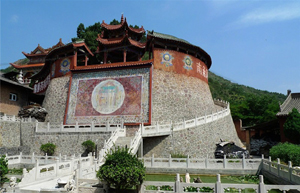
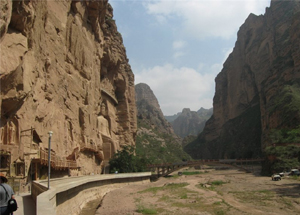
|
Located in the Greater and Minor Jishi (Piled Stone) Hills some 35 kilometers to the southwest of Yongjing County, the Bingling Grotto Temple was chiseled out on the western cliff of the Dasi (Great Temple) Valley on the right of the Yellow River. The Jishi Hills, though dotting on the Northwest Plateau, enjoys yet an exclusively charming and elegant landscape.
The geological formation of the Ijishi Hills where lies the Bingling Grotto Temple is of fine sandstone structure which is easier to be caved and engraved. However, it does not resist weathering and water erosion. As the air is dry here and moreover the higher part of the cliff is normally jutting out to form an eave-like shade, which has helped shelter away strong sunshine and the wash of rainwater. Therefore, the grottos and figures remain still intact and well preserved though quite a long time has already gone by.
The Bingling Grotto Temple is located at a transportation hub on e feeder line of the ancient Silk Road leading from China to the western countries. Buddhists started to cave grottos and sculptures as early as the Western Jin Dynasty. During the period of the Sixteen states, the nobles of he Xianbei ethnic tribe established the Western Qin Regime here. They were for the Buddhism cult and so many eminent monks from inland and western regions swarmed to the place, preaching and sermonizing. The Dasi Valley in the Minor Jishi Hills within the territory of the Western Qin, namely the area where Bingling Temple was located come to be the Buddhist venue of the time.
|
Grand Buddha Temple at Zhangye
|

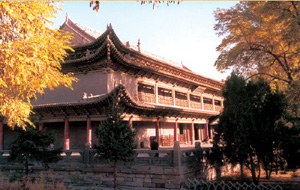
|
Located in the southwest corner of Zhangye City the Grand Buddha Temple derived its name from the fact that there exists a Buddha in a state of nirvana in the temple, the biggest of its kind in China. Built in 1098, the first year under the reign of Yong’an of the Western Xia Dynasty the temple was put up due to a record in history, saying that Wei Yang, national master monk of the Western Xia Dynasty once found a reclining Buddha under a piece of green tile when digging at the place.
The buildings now in existence include the Grand Buddha Hall, the Buddhist Scripture Storage and the Earthen Pagoda. Standing 33 meters high the Grand Buddha Hall is of nine bays, looking quite specious and magnificent. Both sides of the gate are inserted with a carved brick-piece of 6 square meters, one on each side. That on the left reads “Ascending to the Paradise” and “Wonderland in Western Heaven” and that on the right “Into an Enlightened World” and “Preaching in the Realm of Buddhism”. Lying in the hall is the Recumbent Buddha, a clay and wood sculpture of 34.5 meters in length with that measuring 7.5 meters between two shoulders, 4 meters for his foot and 2 meters for the ear. All gilded it looks vivid and lifelike, seeming to be awake when looking at it yet it is asleep if stirred up. Sculptured behind the reclining Buddha are his ten disciples and on both sides of the hall are seen the 18 arhats and the walls are painted with murals Pilgrimage to the West and Chinese Fables about Changes. Kept in the Buddhist Scripture Storage are more then 6,000 volumes of sutras granted by Emperor Yingzong of the Ming Dynasty. Well kept and written in gold and silver they are the most precious relics of the temple. The Earthen Pagoda stands 33.37 meters high behind the temple. As one of the five elements’ pagodas in Zhangye, at the corners of the first two platforms are built with little pagodas of an elephant style, a rare object to be found in the country.
As said, the Grand Buddha Temple in Zhangye was the birthplace of Kublai Klan and so the imperial queen mother’s coffin was kept in the temple. At the end of the Southern Song Dynasty, Emperor Gongzong by the name of Zhao Xian was ordained here for avoiding political disturbances after he was taken a captive. The Grand Buddha Temple used to be a huge temple in the 16th century for 4,000-5,000 monks to do religious service simultaneously.
Cited from:
Gao Yafang & Qin Binfeng (2008). The Tour Guides’ Speech Collection About Gansu [M]. Beijing: China Travel and Tourism Press
Han Rongliang & Han Zhiyu (2006). Guide to Gansu [M].Beijing: China Travel and Tourism Press
|







